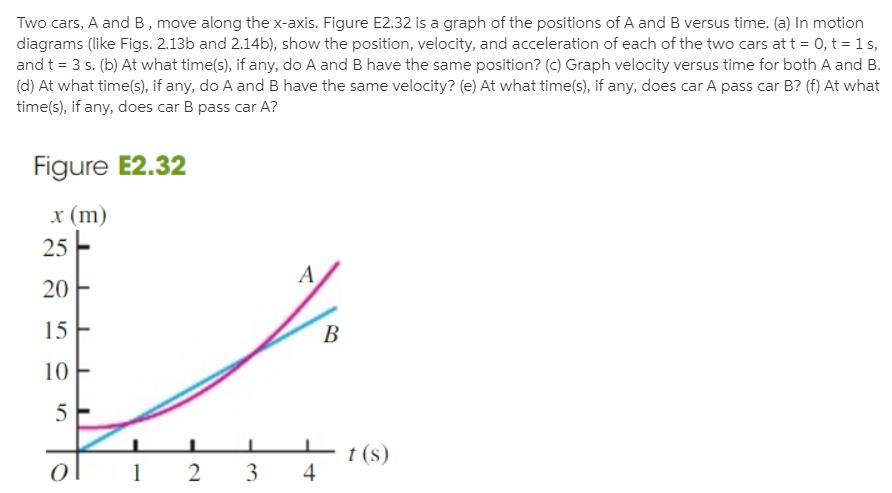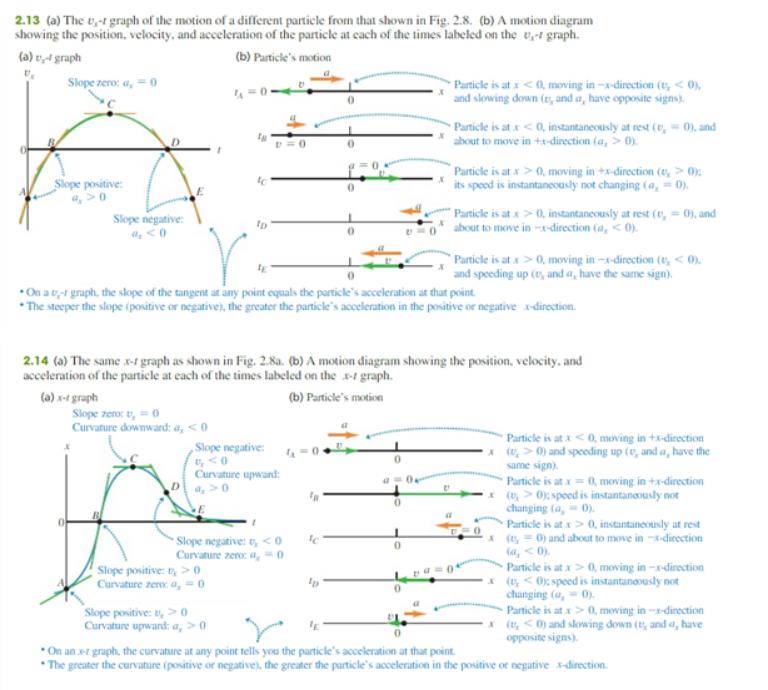Answered step by step
Verified Expert Solution
Question
1 Approved Answer
Two cars, A and B, move along the x-axis. Figure E2.32 is a graph of the positions of A and B versus time. (a)


Two cars, A and B, move along the x-axis. Figure E2.32 is a graph of the positions of A and B versus time. (a) In motion diagrams (like Figs. 2.13b and 2.14b), show the position, velocity, and acceleration of each of the two cars att 0, t 1s, and t = 3 s. (b) At what time(s), if any, do A and B have the same position? (c) Graph velocity versus time for both A and B. (d) At what time(s), if any, do A and B have the same velocity? (e) At what time(s), if any, does car A pass car B? (f) At what time(s), if any, does car B pass car A? Figure E2.32 x (m) 25 - A 20 15 B 10 t (s) 4 1 2 2.13 (a) The t,-t graph of the motion of a different particle from that shown in Fig. 2.8. (b) A motion diagram showing the position, velocity, and acceleration of the particle at each of the times labeled on the vt graph. (a) v;4 graph (b) Particle's motion Slope zero: a, = 0 Particle is at x 0, moving in +x-direction (t, > 0). its speod is instantaneously not changing (a, 0). Slope positive: a, >0 Slope negative: Particle is at x> 0, instantaneously at rest (v, = 0), and about to move in --direction (a, < 0). Particle is at x> 0, moving in -a-direction (t, < 0). and speeding up (v, and a, have the same sign). *On a t-1 graph, the slope of the tangent at any point equals the particke's acceleration at that point. * The steeper the slope (positive or negative), the greater the particle's acceleration in the positive or negative xdirection. 2.14 (a) The same x-r graph as shown in Fig. 2.8a. (b) A motion diagram showing the position, velocity. and acceleration of the particle at each of the times labeled on the x-t graph. (b) Particle's motion Slope zero: t, = 0 Curvature downward: a, < 0) Particle is at a 0) and speeding up (e, and a, have the same sign). Particle is at x = 0, moving in +x-direction (v, > 0): speed is instantanosusly not changing (a, 0). Particle is at x> 0, instantaneously at rest (e, = 0) and about to move in --direction (a, < 0). Particle is at x>0, moving in -r-direction * (t, < 0): speed is instantanovusly not changing (a, = 0). Particle is at x>0, moving in -x-direction * (t, 0 Curvature upward: a, >0 *On an r graph, the curvature at any point tells you the particle's acceleration at that point. * The greater the curvature (positive or negative), the greater the particle's acceleration in the positive or negative x-direction.
Step by Step Solution
★★★★★
3.43 Rating (156 Votes )
There are 3 Steps involved in it
Step: 1

Get Instant Access to Expert-Tailored Solutions
See step-by-step solutions with expert insights and AI powered tools for academic success
Step: 2

Step: 3

Ace Your Homework with AI
Get the answers you need in no time with our AI-driven, step-by-step assistance
Get Started


